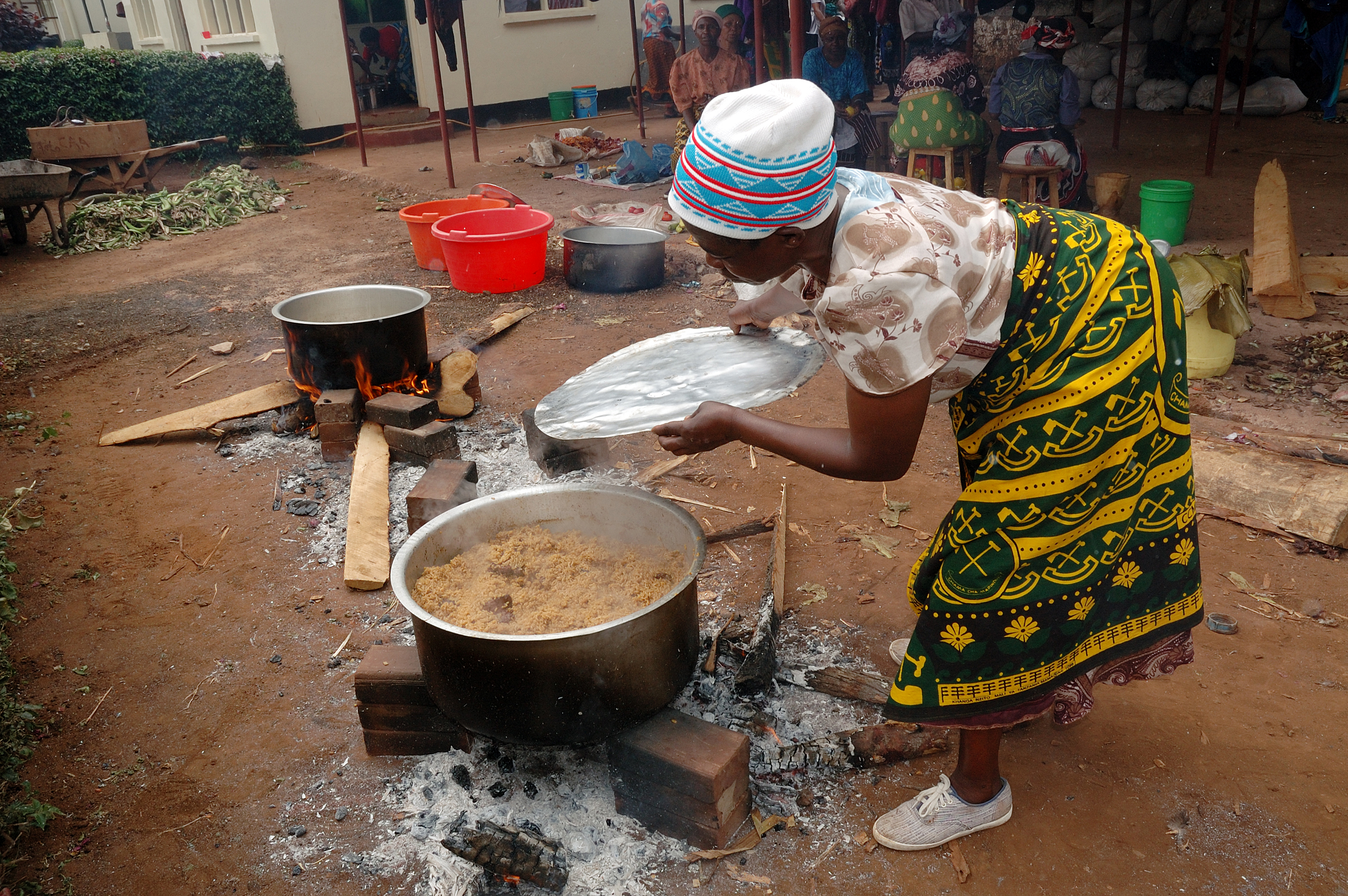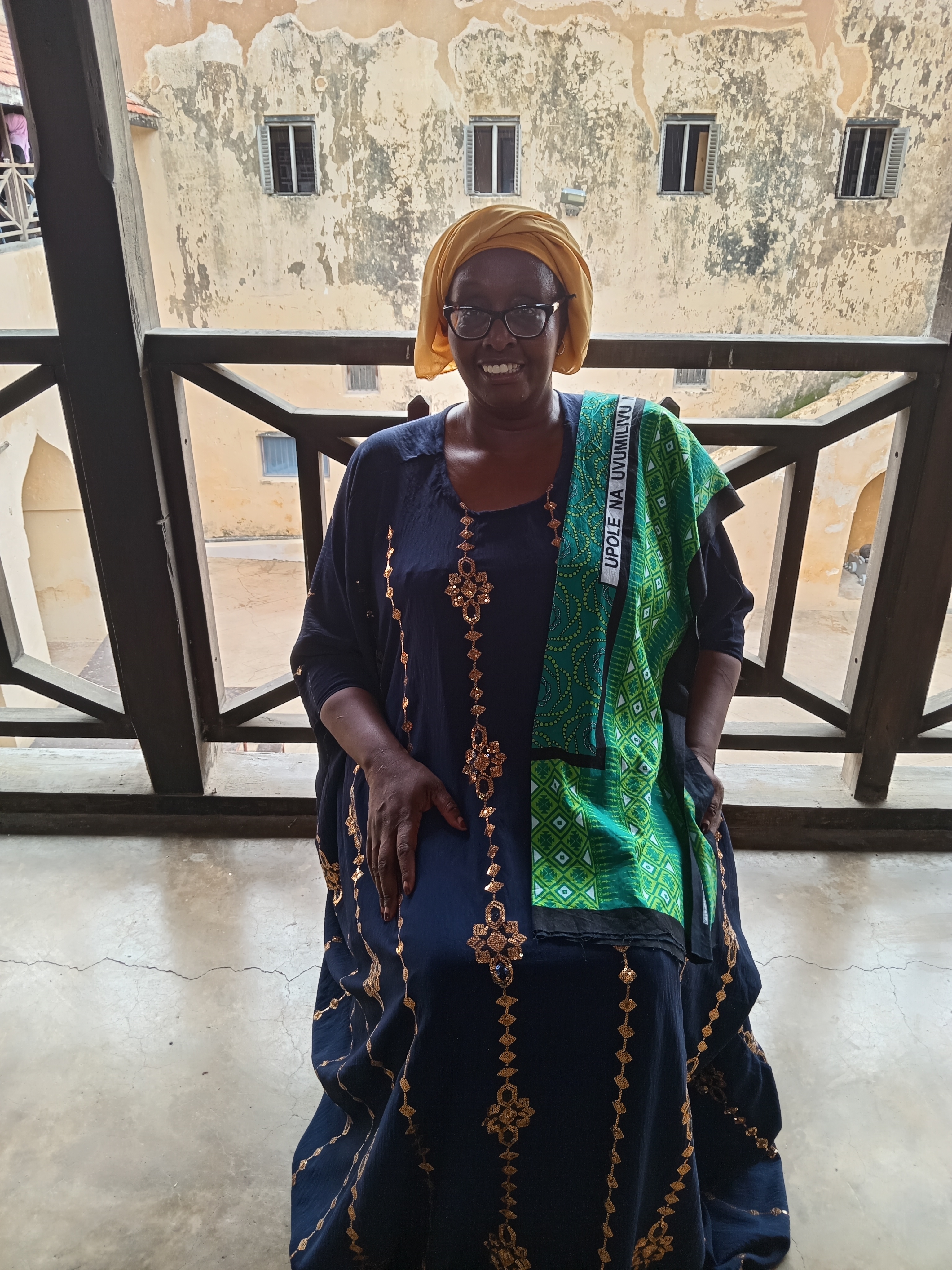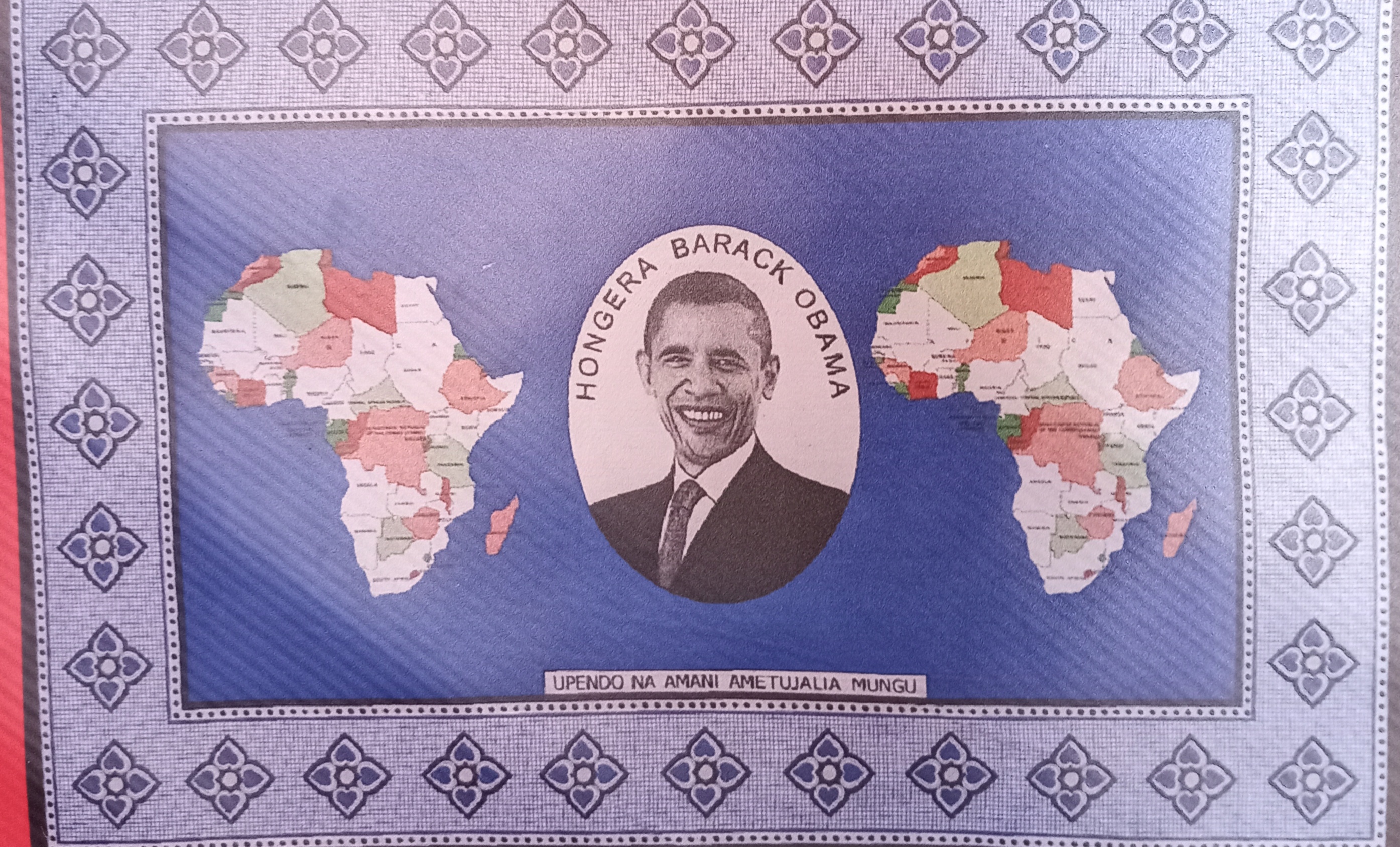Khanga on:
[Wikipedia]
[Google]
[Amazon]
The kanga (in some areas known as leso) is a colourful fabric similar to
 Kangas have been a traditional type of dress amongst women in
Kangas have been a traditional type of dress amongst women in
 In the early 1900s, proverbs, sayings, aphorisms and slogans were added to kangas. A trader in Mombasa, Kaderdina Hajee Essak, also known as "Abdulla", began to distinguish his kangas with the mark "K.H.E. - Mali ya Abdulla", to which he often added a proverb in Swahili. Initially they were printed in
In the early 1900s, proverbs, sayings, aphorisms and slogans were added to kangas. A trader in Mombasa, Kaderdina Hajee Essak, also known as "Abdulla", began to distinguish his kangas with the mark "K.H.E. - Mali ya Abdulla", to which he often added a proverb in Swahili. Initially they were printed in
 There are many different ways to wear kangas. One traditional way of wearing the kanga is to wrap one piece as a shawl, to cover the head and shoulders, and another piece wrapped around the waist. Kangas are also used as baby carriers. It can also be used by women for the Swahili traditional dance chakacha.
There are many different ways to wear kangas. One traditional way of wearing the kanga is to wrap one piece as a shawl, to cover the head and shoulders, and another piece wrapped around the waist. Kangas are also used as baby carriers. It can also be used by women for the Swahili traditional dance chakacha.
 Kanga can also be used to send political messages, mostly used during the campaign time Women will wear a specific Kanga to communicate a non-verbal message to their community. This form of communication, often between women can be about personal feeling, relationship, political, education. health or religion
Kanga can also be used to send political messages, mostly used during the campaign time Women will wear a specific Kanga to communicate a non-verbal message to their community. This form of communication, often between women can be about personal feeling, relationship, political, education. health or religion
'Ambiguous signs: the role of the 'kanga' as a medium of communication'
''Afrikanistische Arbeitspapiere'', 68, 157–169. * Erie Art Museum
* Hanby, Jeanette & David Bygott, (2006) 'Kangas - 101 Uses', HariaStamp Publishers, * Hongoke, Christine J. (1993) ''The effects of Khanga inscription as a communication vehicle in Tanzania'', Research report, 19. Dar es Salaam: Women's Research and Documentation Project. * Linnebuhr, E. (1992) 'Kanga: popular cloths with messages', in Werner Graebner (ed.) ''Sokomoko: Popular Culture in East Africa'' (Matatu vol. 9). Rodopi, 81–90. * Parkin, David (2004) 'Textile as commodity, dress as text: Swahili ''kanga'' and women's statements', in Ruth Barnes (ed.) ''Textiles in Indian Ocean Societies''. London/New York: Routledge, 47–67. * Yahya-Othman, Saida (1997
'If the cap fits: 'kanga' names and women's voice in Swahili society'
''Afrikanistische Arbeitspapiere'', 51, 135–149. * Kahabi, CM. (2010) Kanga and Vitenge in Remanufactured Fashion; University of Manchester.
{{in lang, en
African clothing East Africa Skirts Swahili culture
kitenge
A kitenge or chitenge (pl. vitenge Swahili language, Swahili; zitenge in Tonga people of Zambia and Zimbabwe, Tonga) is an East African, West Africa, West African and Central Africa, Central African piece of fabric similar to a sarong, often w ...
, but lighter, worn by women and occasionally by men throughout the African Great Lakes
The African Great Lakes (; ) are a series of lakes constituting the part of the Rift Valley lakes in and around the East African Rift. The series includes Lake Victoria, the second-largest freshwater lake in the world by area; Lake Tangan ...
region. It is a piece of printed cotton
Cotton (), first recorded in ancient India, is a soft, fluffy staple fiber that grows in a boll, or protective case, around the seeds of the cotton plants of the genus '' Gossypium'' in the mallow family Malvaceae. The fiber is almost pure ...
fabric
Textile is an umbrella term that includes various fiber-based materials, including fibers, yarns, filaments, threads, and different types of fabric. At first, the word "textiles" only referred to woven fabrics. However, weaving is no ...
, about 1.5 m by 1 m, often with a border along all four sides (called ''pindo'' in Swahili), and a central part (''mji'') which differs in design from the borders. They are sold in pairs, which can then be cut and hemmed to be used as a set.
Origins
 Kangas have been a traditional type of dress amongst women in
Kangas have been a traditional type of dress amongst women in East Africa
East Africa, also known as Eastern Africa or the East of Africa, is a region at the eastern edge of the Africa, African continent, distinguished by its unique geographical, historical, and cultural landscape. Defined in varying scopes, the regi ...
since the 19th century.
Merikani
According to some sources, it was developed from a type of unbleached cotton cloth imported from the US. The cloth was known as ''merikani'' in Zanzibar, a Swahilinoun
In grammar, a noun is a word that represents a concrete or abstract thing, like living creatures, places, actions, qualities, states of existence, and ideas. A noun may serve as an Object (grammar), object or Subject (grammar), subject within a p ...
derived from the adjective
An adjective (abbreviations, abbreviated ) is a word that describes or defines a noun or noun phrase. Its semantic role is to change information given by the noun.
Traditionally, adjectives are considered one of the main part of speech, parts of ...
''American'' (indicative of the place it originated). Male slaves wrapped it around their waist and female slaves wrapped it under their armpits. To make the cloth more feminine, slave women occasionally dyed them black or dark blue, using locally obtained indigo. This dyed merikani was referred to as kaniki. People despised kaniki due to its association with slavery. Ex-slave women seeking to become part of the Swahili society began to decorate their merikani clothes. They did this using one of three techniques; a form of resist dying, a form of block printing or hand painting. After slavery was abolished in 1897, Kangas began to be used for self-empowerment and to indicate that the wearer had personal wealth.
Lenços
According to other sources, the origin is in the kerchief squares called ''lencos'' brought by Portuguese traders from India and Arabia. Stylish ladies inZanzibar
Zanzibar is a Tanzanian archipelago off the coast of East Africa. It is located in the Indian Ocean, and consists of many small Island, islands and two large ones: Unguja (the main island, referred to informally as Zanzibar) and Pemba Island. ...
and Mombasa
Mombasa ( ; ) is a coastal city in southeastern Kenya along the Indian Ocean. It was the first capital of British East Africa, before Nairobi was elevated to capital status in 1907. It now serves as the capital of Mombasa County. The town is ...
, started to use them stitching together six kerchiefs in a 3X2 pattern to create one large rectangular wrap. Soon they became popular in the whole coastal region, later expanding inland to the Great Lakes region. They are still known as ''lesos'' or ''lessos'' in some localities, after the Portuguese word.
Manufacture
Until the mid-twentieth century, they were mostly designed and printed in India, the Far East and Europe. Since the 1950s kangas started to be printed also in the city of Morogoro in Tanzania (MeTL Group Textile Company) and Kenya (Rivatex and Thika Cloth Mills Ltd are some of the largest manufacturers in Kenya) and other countries on the African continent.Proverbs
 In the early 1900s, proverbs, sayings, aphorisms and slogans were added to kangas. A trader in Mombasa, Kaderdina Hajee Essak, also known as "Abdulla", began to distinguish his kangas with the mark "K.H.E. - Mali ya Abdulla", to which he often added a proverb in Swahili. Initially they were printed in
In the early 1900s, proverbs, sayings, aphorisms and slogans were added to kangas. A trader in Mombasa, Kaderdina Hajee Essak, also known as "Abdulla", began to distinguish his kangas with the mark "K.H.E. - Mali ya Abdulla", to which he often added a proverb in Swahili. Initially they were printed in Arabic script
The Arabic script is the writing system used for Arabic (Arabic alphabet) and several other languages of Asia and Africa. It is the second-most widely used alphabetic writing system in the world (after the Latin script), the second-most widel ...
, and later in Roman letters
The Latin script, also known as the Roman script, is a writing system based on the letters of the classical Latin alphabet, derived from a form of the Greek alphabet which was in use in the ancient Greek city of Cumae in Magna Graecia. The Gree ...
. Towards the eastern part of the region, phrases in Kiswahili
Swahili, also known as as it is referred to in the Swahili language, is a Bantu language originally spoken by the Swahili people, who are found primarily in Tanzania, Kenya, and Mozambique (along the East African coast and adjacent littoral i ...
are traditional, while in central areas phrases in both Kiswahili and Lingala
Lingala (or Ngala, Lingala: ) is a Bantu languages, Bantu language spoken in the northwest of the Democratic Republic of the Congo, the northern half of the Republic of the Congo, in their capitals, Kinshasa and Brazzaville, and to a lesser de ...
are popular.
Appearance
* Generally Kangas are 150 cm wide by 110 cm long. * They are rectangular and always have a border along all four sides. * Often kangas have a central symbol. * Most modern kangas bear a saying, usually in Kiswahili.Kanga Wear Designs
 There are many different ways to wear kangas. One traditional way of wearing the kanga is to wrap one piece as a shawl, to cover the head and shoulders, and another piece wrapped around the waist. Kangas are also used as baby carriers. It can also be used by women for the Swahili traditional dance chakacha.
There are many different ways to wear kangas. One traditional way of wearing the kanga is to wrap one piece as a shawl, to cover the head and shoulders, and another piece wrapped around the waist. Kangas are also used as baby carriers. It can also be used by women for the Swahili traditional dance chakacha.
Kanga Uses
Whereaskitenge
A kitenge or chitenge (pl. vitenge Swahili language, Swahili; zitenge in Tonga people of Zambia and Zimbabwe, Tonga) is an East African, West Africa, West African and Central Africa, Central African piece of fabric similar to a sarong, often w ...
is a more formal fabric used for nice clothing, the kanga is much more than a clothing piece, it can be used as a skirt, head-wrap, apron, pot-holder, towel, and much more. The kanga is culturally significant on Eastern coast of Africa, often given as a gift for birthdays or other special occasions. They are also given to mourning families in Tanzania after the loss of a family member as part of a michengo (or collection) into which many community members put a bit of money to support the family in their grief. Kangas are also similar to Kishutu and Kikoy
A sarong or a sarung (, ) is a large tube or length of fabric, often wrapped around the waist, worn in Southeast Asia, South Asia, Western Asia, Northern Africa, East Africa, West Africa, and on many Pacific islands. The fabric often employs w ...
which are traditionally worn by men. The Kishutu is one of the earliest known designs, probably named after a town in Tanzania, they are particular given to young brides as part of their dowry or by healers to cast off evil spirits. Due to its ritual function they do not always include a proverb.
The earliest pattern of the kanga was patterned with small dots or speckles, which look like the plumage of the guinea hen, also called "kanga" in Swahili. This is where the name comes from, contrary to the belief that it comes from a Swahili verb for to close.
Communication vehicle
Typically, kangas consist of three parts: The ''pindo'' (wide border), the ''mji'' (central motif), ''Ujumbe'' or ''jina'' (the Kiswahili) is featured on a strip which contains a message. It is less commonly written inArabic
Arabic (, , or , ) is a Central Semitic languages, Central Semitic language of the Afroasiatic languages, Afroasiatic language family spoken primarily in the Arab world. The International Organization for Standardization (ISO) assigns lang ...
or Comorian. Other countries which produce their own Kangas write the Kanga messages/names in their main languages: in Madagascar
Madagascar, officially the Republic of Madagascar, is an island country that includes the island of Madagascar and numerous smaller peripheral islands. Lying off the southeastern coast of Africa, it is the world's List of islands by area, f ...
(Malagasy Republic) where they are known as lambas, they feature ohabolana
Hainteny (pronounced , Malagasy for "knowledge of words") is a traditional form of Malagasy oral literature and poetry, involving heavy use of metaphor. It is associated primarily with the Merina people of Madagascar. In its use of metaphor an ...
, traditional proverbs written in Malagasy; they are also produced in Zambia
Zambia, officially the Republic of Zambia, is a landlocked country at the crossroads of Central Africa, Central, Southern Africa, Southern and East Africa. It is typically referred to being in South-Central Africa or Southern Africa. It is bor ...
and Malawi
Malawi, officially the Republic of Malawi, is a landlocked country in Southeastern Africa. It is bordered by Zambia to the west, Tanzania to the north and northeast, and Mozambique to the east, south, and southwest. Malawi spans over and ...
. This message is called the ''jina'' (literally 'name') of the kanga. Messages are often in the form of riddles or proverbs. When giving a kanga as a gift, one must be mindful of the proverb, as they can be somewhat insulting. Occasionally, one of these is given as a gift at a wedding to express a person's opinion that the couple should not be married. However, most of the messages express kind sentiments and good wishes. Some examples of proverbs:
*''Majivuno hayafai'': Greed is never useful
*''Mkipendana mambo huwa sawa'': Everything is all right if you love each other
*''Japo sipati tamaa sikati'': Even though I have nothing, I have not given up my desire to get what I want
*''Wazazi ni dhahabu kuwatunza ni thawabu'': Parents are gold; to take care of them is a blessing
*''Sisi sote abiria dereva ni Mungu'': We are all passengers, God is the driver
*''Fimbo La Mnyonge Halina Nguvu'': Might is right. (lit. "the weak stick has no power")
*''Mwanamke mazingira tuanataka, usawa, amani, maendelo'': We (women) want equality, peace, and progress
*''Naogopa simba na meno yake siogopi mtu kwa maneno yake'': I'm afraid of a lion with its strong teeth but not a man with his words (lyrics).
*''Leo ni siku ya shangwe na vigelegele'': Today is a day for celebrations and ululations.
*''Mchungulia bahari si msafiri'': One who only looks at the sea is not a sailor.
Political Vehicle
 Kanga can also be used to send political messages, mostly used during the campaign time Women will wear a specific Kanga to communicate a non-verbal message to their community. This form of communication, often between women can be about personal feeling, relationship, political, education. health or religion
Kanga can also be used to send political messages, mostly used during the campaign time Women will wear a specific Kanga to communicate a non-verbal message to their community. This form of communication, often between women can be about personal feeling, relationship, political, education. health or religionSee also
* CapulanaNotes
Literature
* Beck, Rose-Marie (2001)'Ambiguous signs: the role of the 'kanga' as a medium of communication'
''Afrikanistische Arbeitspapiere'', 68, 157–169. * Erie Art Museum
* Hanby, Jeanette & David Bygott, (2006) 'Kangas - 101 Uses', HariaStamp Publishers, * Hongoke, Christine J. (1993) ''The effects of Khanga inscription as a communication vehicle in Tanzania'', Research report, 19. Dar es Salaam: Women's Research and Documentation Project. * Linnebuhr, E. (1992) 'Kanga: popular cloths with messages', in Werner Graebner (ed.) ''Sokomoko: Popular Culture in East Africa'' (Matatu vol. 9). Rodopi, 81–90. * Parkin, David (2004) 'Textile as commodity, dress as text: Swahili ''kanga'' and women's statements', in Ruth Barnes (ed.) ''Textiles in Indian Ocean Societies''. London/New York: Routledge, 47–67. * Yahya-Othman, Saida (1997
'If the cap fits: 'kanga' names and women's voice in Swahili society'
''Afrikanistische Arbeitspapiere'', 51, 135–149. * Kahabi, CM. (2010) Kanga and Vitenge in Remanufactured Fashion; University of Manchester.
External links
{{in lang, en
African clothing East Africa Skirts Swahili culture